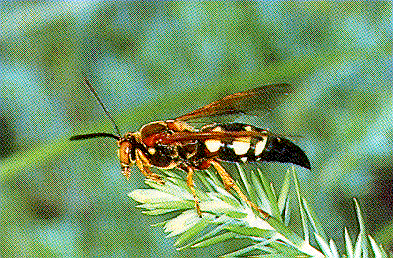Cicada Killer Wasp
or Giant
Cicada Killer or Sand Hornet
The Cicada Killer Wasp
Sphecius speciosus, is 1.5 to 2.0 inches long (Females are twice
the size of males), and is brownish black with
yellow markings on the abdomen and face. Their wings are amber.
Cicada Killers
Sphecius speciosus are present in the eastern
United States, east of the Rocky Mountains. There are a handful of species in
the genus Sphecius within the United States, and a species in the western United
States, known as Sphecius convallis, is termed the Western Cicada Killer. It is
the largest wasp in California. Cicada Killers appear as adults in late June or
July, and are mostly seen visiting flowers or digging burrows in sandy or light
soil. In Washington, D. C., they are commonly seen in July on the National Mall.
Cicada killers are around at the time that coincides with the presence of their
cicada prey.

Picture taken by
Cliff Sadow
While their size is intimidating,
cicada killers are not aggressive and will sting humans only if pinned
against the skin.
The female digs a burrow in the soil. These insects prefer
to dig their burrows in sandy, bare, well drained soil exposed to full
sunlight. It captures cicadas,
paralyzing them by stinging, and places them in the burrow. An egg is
deposited on each cicada and that cell is closed off. Cicada killer wasps
produce one generation per year, with larvae spending the winter in the
nest cell in the soil. Females live only about 30 days. By mid-September
they are hard to find.

photo courtesy of University of Florida Entomology
The only damage these wasps cause are unsightly dirt piles
dug out to create nests. They usually disappear with the first rain.
Since
cicada killers are so beneficial, control efforts are not recommended.
In spite of their large size, the wasps
usually ignore people but they can give a painful sting if bothered. Mating
males are aggressive and more easily disturbed. But they have no stinger and so
they are harmless!
More information here (Prof.
Chuck Holliday's Cicada Killer Page):
http://ww2.lafayette.edu/~hollidac/cicadakillerhome.html
next
page: Oriental Hornet
Guestbook
Guestbook 1998 - 2007

Hymenoptera>Vespoidea>Vespidae>Vespa
crabro>Hornisse>Hornet>Frelon>Hoornaar>Vespa
grande>Abejorro>Calabrone
Hymenoptera>Vespoidea>Vespidae>Vespa
crabro>Hornisse>Hornet>Frelon>Hoornaar>Vespa grande>Abejorro>Calabrone
Webmaster:
Dieter Kosmeier
Hymenoptera>Vespoidea>Vespidae>Vespa
crabro>Hornisse>Hornet>Frelon>Hoornaar>Vespa grande>Abejorro>Calabrone
Hymenoptera>Vespoidea>Vespidae>Vespa
crabro>Hornisse>Hornet>Frelon>Hoornaar>Vespa grande>Abejorro>Calabrone

www.vespa-crabro.de
|